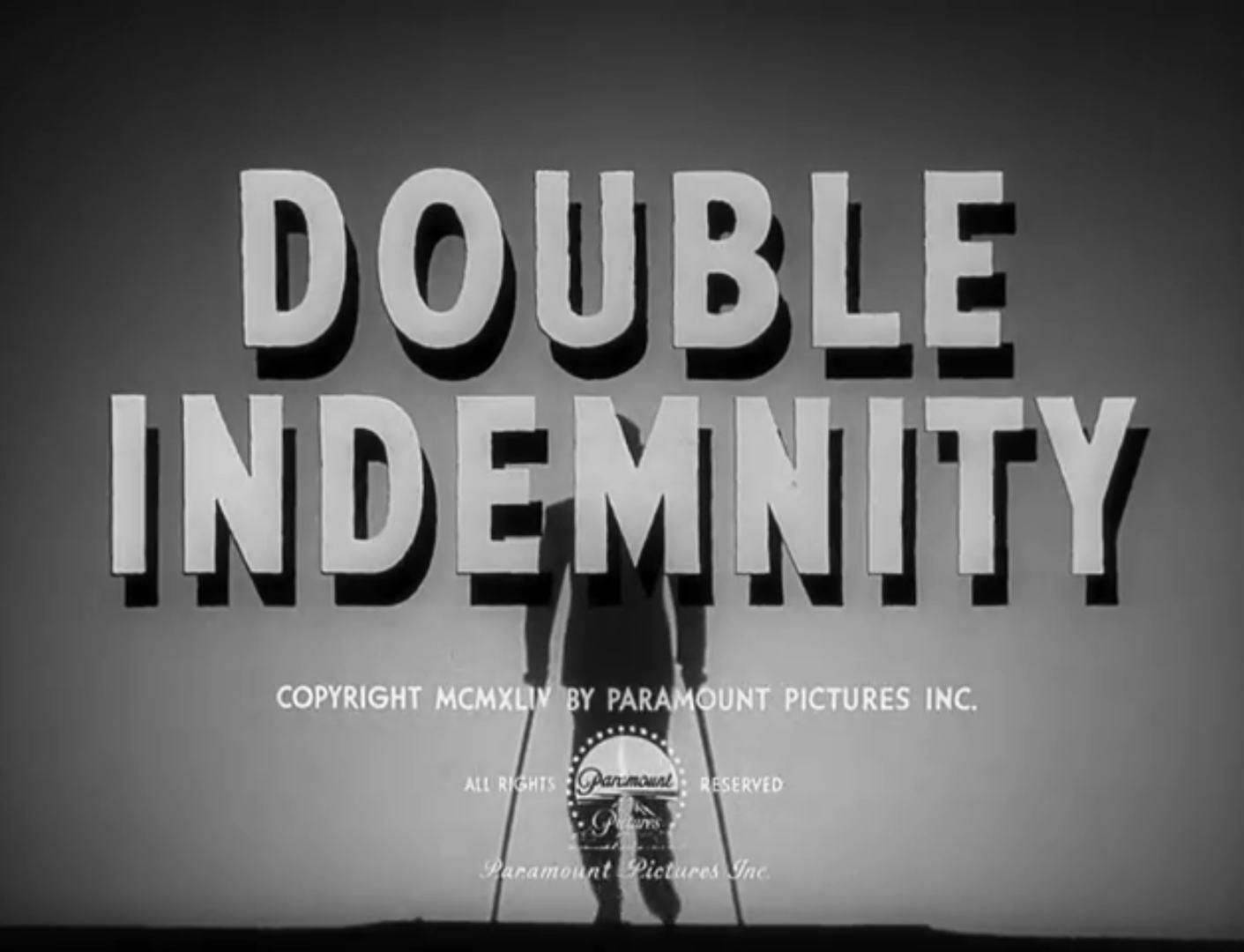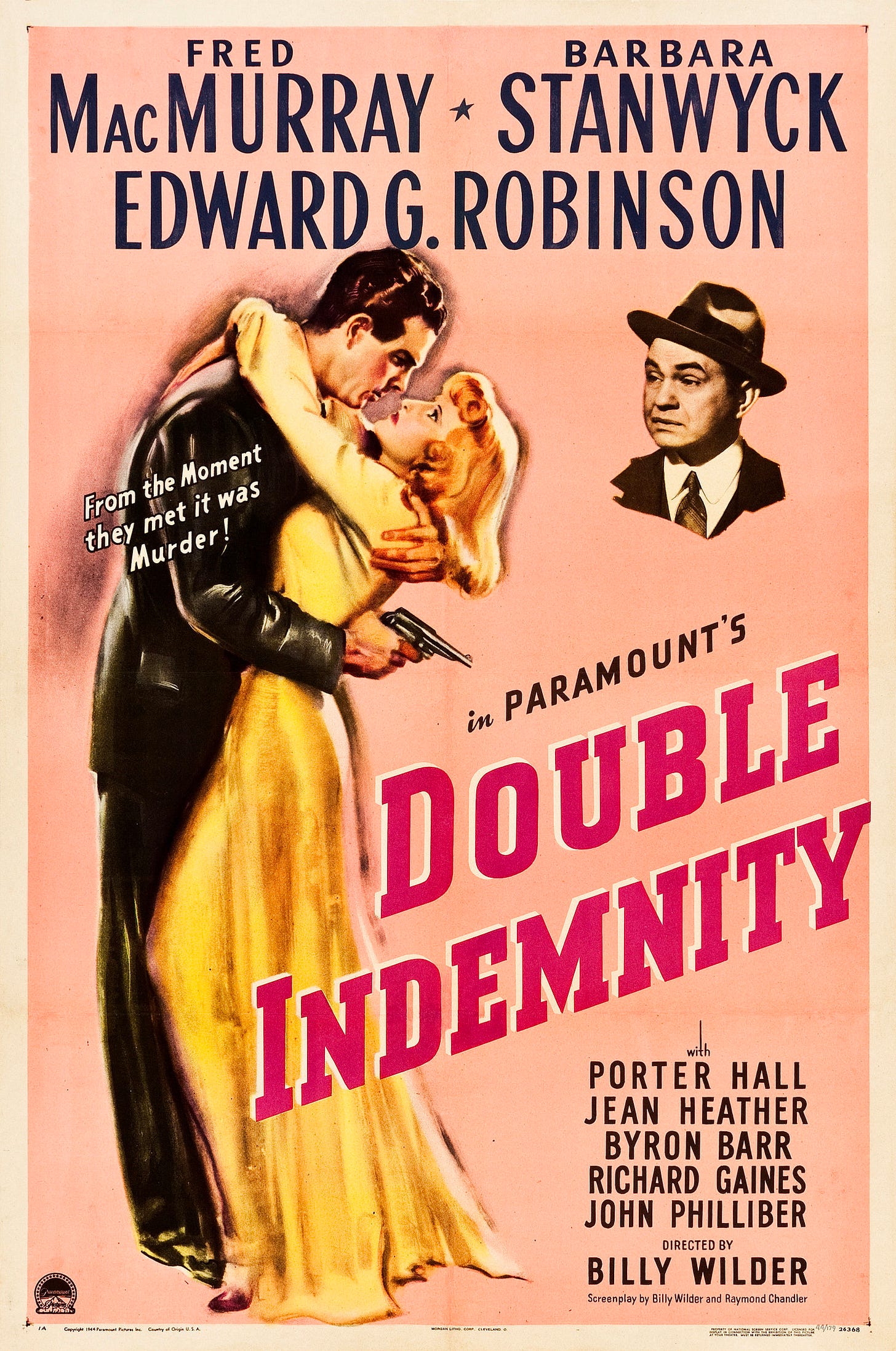PLOT
An insurance salesman falls for a married woman and, together, they conspire to commit the perfect murder for a hefty insurance payout. But things don’t quite go as planned...
REVIEW
I remember watching the 1973 TV remake (with Richard Crenna) and not being particularly impressed. That experience did not make me want to watch the original when I discovered there had been an earlier version. As the years passed, however, I kept hearing positive feedback about the Billy Wilder film... And so, at long last, I went ahead and watched it.
Interestingly, the screenplay was co-written by a famous author (Raymond Chandler) and based on a novel by another famous author (James M. Cain). While researching for this article, I also discovered that the novel itself was inspired by the real-life story of Ruth Snyder—the first woman to be executed in the electric chair. The sentence was pronounced after she was found guilty of murdering her husband with the help of her lover and of an insurance salesman. If you’re curious about the details, you can read all about it here.
It has been a long time since I’ve seen the remake, so I remembered nothing of the plot going in. And while I wouldn’t call it a masterpiece, it was an enjoyable experience.
One thing I found interesting here is how the film starts with a confession: an insurance salesman claims to have murdered a man, and to have done it for money and for a woman. In other words, we are told the end before the story even begins. Many other films and TV shows have of course used this technique over the years, most famously every single episode of Columbo where the fun was trying to figure out how the detective would piece things together. A more recent Canadian show, Motive, followed a similar pattern where viewers saw the crime being committed but then had to guess, along with the investigators, how the victim and the killer were connected and what the latter’s motive was. It also reminds me of the criminally forgotten “D.O.A.” (1988) where a man (played by Danny Quaid) staggers into a police station to report his own murder.
Another thing “Double indemnity” has in common with “D.O.A.” is its structure. Both of them start at the end and then proceed to tell the main story as a lengthy flashback with a voice-over from the main character narrating what happened.
Obviously, with such a structure, the viewer’s focus shifts. It no longer is about finding out how the story will end, but rather how the character could possibly have found himself in such a nightmarish situation. For this to work, the opening scene is vital, as it must be intriguing enough to hook the viewer’s attention. Interestingly, both “D.O.A.” and “Double indemnity” achieve this by presenting a dying hero who has a story to tell.
The film’s strengths lie in its sharp script, expert direction, noir cinematography, and standout performances from the three main leads.
Fred MacMurray’s acting is a departure from his usual affable on-screen persona, and he excels in portraying the morally conflicted Neff. His cynical and rapid-fire dialogue delivery captures the essence of film noir’s hard-boiled aesthetic, making Neff a compelling and morally ambiguous protagonist.
Of course, no movie can claim to be a film noir without a femme fatale. The part is played here by Barbara Stanwyck. Her seductive allure, coupled with a cool and calculating demeanor, creates a magnetic on-screen presence. The actress navigates the complexities of Phyllis’s character, shifting effortlessly between vulnerability and manipulation. The chemistry between her and MacMurray is palpable, and their interactions are charged with tension, making the audience both repulsed and fascinated by the toxic dynamic between the characters. Their first conversation, in particular, is filled with delicious double entendres; while the second reveals the woman’s sinister plot and shows that Neff is no idiot—he immediately understands what she has in mind.
And then there is the wonderful Edward G. Robinson. His character, Barton Keyes, is an astute claims adjuster who brings a mix of wit, warmth, and relentless determination to the plot. Keyes serves as the moral compass of the story, unraveling the intricacies of the insurance fraud scheme with keen intuition. The actor’s dynamic presence provides a counterbalance to the darker elements of the narrative and elevates the film’s thematic exploration of morality and justice. And, let’s be honest, he steals every single scene he appears in!
Despite the dark visuals and tone, humor is not completely absent. It can be found in the dialogues, through occasional quips, but also through some of the characters’ actions. Most notably Keyes’ recurring inability to find a match, which Neff helpfully produces each time.
Billy Wilder’s direction is exemplary, showcasing his skill in creating a moody and atmospheric noir landscape. The film is marked by high-contrast lighting, stark shadows, and evocative compositions, all hallmarks of the noir visual style. The cinematography complements the director’s vision, capturing the essence of the genre with its lighting and expressive camera work. The visual elements contribute to the film’s overall sense of dread and moral ambiguity, enveloping the characters in a world where shadows conceal as much as they reveal.
Chandler’s participation in this project ensures that the dialogues are sharp, clever, and laden with subtext. The script’s quick-witted banter and hard-edged repartee add to the film’s noir credentials. The non-linear narrative (with Neff recounting the events into a dictaphone) creates a sense of inevitability and foreboding. The story’s structure, coupled with the memorable dialogue, adds a layer of sophistication to the film.
In hindsight, the film might feel conventional and at times predictable, but this often happens with stories that help start a trend. The tropes of the genre have become so common, that viewers are now jaded and may see them as unoriginal. I’ll admit to falling into this trap myself on occasion. However, if considered in its historical context, one can recognize this movie’s pioneering role in shaping the noir tradition.
My only real issue (and it’s a minor one) with “Double indemnity” is a detail from the opening scene. We see a car speeding down streets, suggesting the driver is in a hurry. Yet, when he arrives at his destination, he slowly makes his way out and up to the office, like he has all the time in the world. Granted, he is wounded, but that does not fully explain his attitude, as once seated at his desk, he takes time to light a cigarette and takes a few puffs before speaking into his dictaphone.
That said, I enjoyed watching this film, even if I don’t consider it the best film noir out there. I’ll happily concede it had an influential role in the development of the genre, but to me it does not hold up to such classics as Preminger’s “Laura” or Huston’s “The Maltese falcon.”
—
Have you watched this film? What did you think of it?
What is your favorite film noir?
Let us know in the comments!
TRIVIA NOTES
Despite his name, director Billy Wilder was born in the Austro-Hungarian Empire (modern-day Poland). He started as a journalist in Vienna, then a dancer in Berlin before becoming a screenwriter. After twelve German films and the rise of Adolf Hitler, he fled to Paris where he made his directorial debut in 1934. He then moved to Hollywood, where he enjoyed a long career. Further credits include “Five graves to Cairo,” “The lost weekend,” “Sunset Boulevard,” “The seven year itch” (starring Marilyn Monroe), “Some like it hot” (again with Monroe), “Irma la douce,” and “The private life of Sherlock Holmes.” His brother W. Lee Wilder was also a director, and he is the uncle of television writer-producer Myles Wilder (best known for his long association with The Dukes of Hazzard).
Raymond Chandler is best known as a crime fiction author and as the father of film noir icon Philip Marlowe. He was (with Dashiell Hammett and James M. Cain) one of the founders of the hardboiled movement. As a screenwriter, he adapted four novels as feature films and wrote one original script (“The blue dahlia” in 1946).
His colleague, James M. Cain, most famously created the Sam Spade character and helped shape the film noir genre. Many of his novels were adapted to the screen, including “The postman always rings twice” and “Mildred Pierce.”
Though his role in “Double indemnity” is his most famous one, Fred MacMurray played the lead in many other films, starting in 1935. His credits include “Car 99,” “The bride comes home,” “True confession,” “Honeymoon in Bali,” “Above suspicion,” “The Caine mutiny,” and “The Oregon Trail.” He is also known for his many appearances in Disney productions (“The shaggy dog,” “The absent-minded professor,” etc.) and for starring in the popular and long-running sitcom My three sons.
Barbara Stanwyck appeared in 85 films over a span of 38 years before focusing her career on television. Feature work includes “Annie Oakley,” “Stella Dallas,” “Remember the night” (also with MacMurray), “Meet John Doe,” “East Side, West Side,” and Jean Negulesco’s “Titanic.” On the small screen, she is perhaps best remembered for playing Victoria Barkley on The big valley and Constance Colby Patterson on The Colbys (also a recurring character on Dynasty). She also guest starred in many other shows, including Wagon train, Rawhide, The untouchables, and Charlie’s angels.
Often cast as a gangster (“Little Caesar,” “Key Largo”...), Edward G. Robinson was also seen in Joseph L. Mankiewicz’s “House of strangers” and DeMille’s “The ten commandments.” Other credits include “Barbary Coast,” “Scarlet Street,” “The Cincinnati Kid,” and “Soylent green.” His son, Edward G. Robinson, Jr. (1933-1974), was also an actor.
Cinematographer John Seitz worked on many high-profile productions, including 1921’s “The four horsemen of the Apocalypse” (starring Rudolph Valentino), “The prisoner of Zenda,” “Kismet,” “The adventures of Huckleberry Finn,” “This gun for hire,” “The lost weekend,” “Night has a thousand eyes,” and “Sunset Boulevard.” He also did the cinematography of two sci-fi classics: “When worlds collide” and “Invaders from Mars.”
Hungarian-born Miklos Rozsa had an international career, composing soundtracks for German, French, British, and American films. He scored many popular and iconic films, including “The thief of Bagdad,” “To be or not to be,” “The jungle book,” Hitchcock’s “Spellbound,” “The naked city,” “Quo vadis,” “Julius Caesar,” “Knight of the Round Table,” “Ben-Hur,” “The private life of Sherlock Holmes,” “The golden voyage of Sinbad,” and “Time after time.”
CREDITS
Directed by Billy Wilder.
Screenplay by Billy Wilder & Raymond Chandler, from the novel by James M. Cain.
Produced by Joseph Sistrom.
Music by Miklos Rozsa.
Cinematography by John Seitz.
Edited by Doane Harrison (editorial supervisor).
Starring Fred MacMurray as Walter Neff, Barbara Stanwyck as Phyllis Dietrichson, Edward G. Robinson as Barton Keyes, Porter Hall as Jackson, Jean Heather as Lola Dietrichson, Tom Powers as Dietrichson, Byron Barr as Nino Zachette, Richard Gaines as Norton, Fortunio Bonanova as truck driver, John Philliber as elevator operator, Raymond Chandler as man reading magazine, Bess Flowers as Norton's secretary, Betty Farrington as Nettie, Teala Loring as Pacific All-Risk telephone operator, Sam McDaniel as Charlie, Miriam Nelson as Keyes' secretary, Douglas Spencer as Lou Schwartz.
Produced by Paramount Pictures.
Distributed by Paramount Pictures.
Released on July 3, 1944.
Running time: 108 minutes.
Genre: Film noir.
—
Share your thoughts in the comments! I would love to hear them.
If you enjoyed this review, please feel free to forward it to your friends or to share it on social media.
And don’t forget to like by clicking the little heart below this post ;)
—
Text (c) 2023 by Alex S. Garcia.
Header image: screenshot of the film’s title card.
Film poster from IMP Awards.





